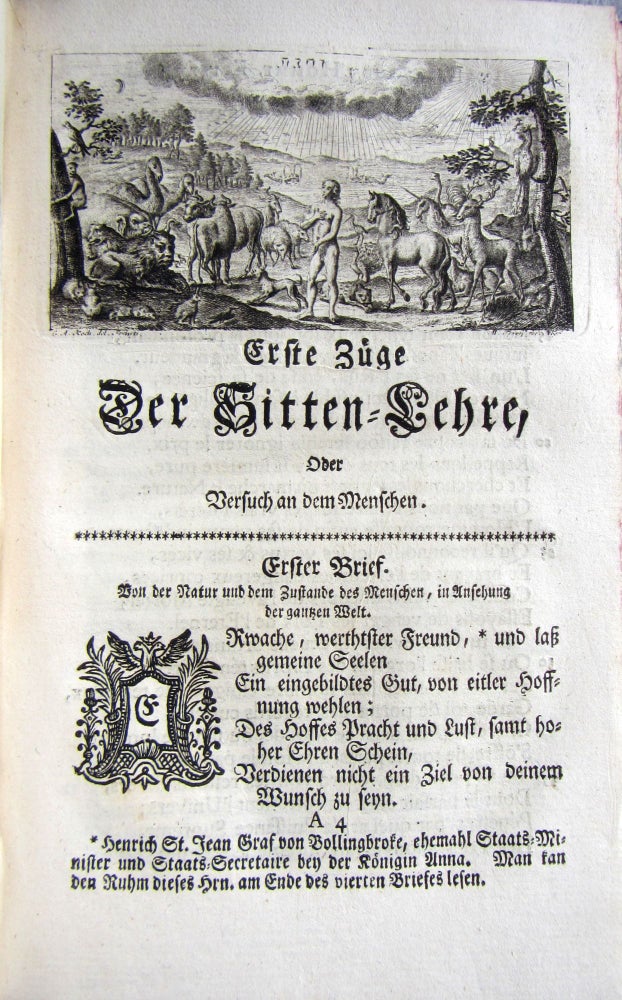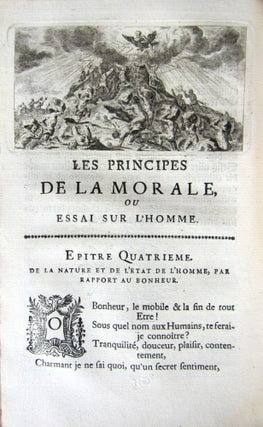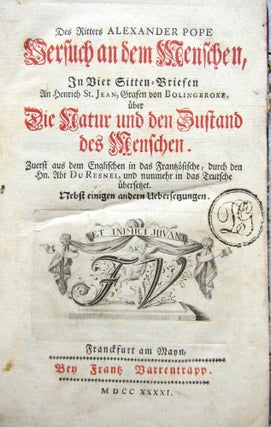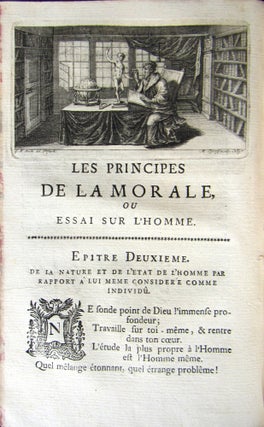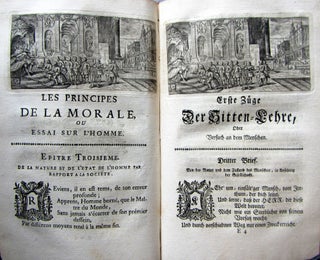Versuch an dem Menschen, In Vier Sitten-Briefen an Henrich St. Jean, Grafen von Bolingbroke, über Die Natur und den Zustand des Menschen. Frankfurt: Franz Varrentrapp, 1741.
8vo (193 x 121 mm). [46], 191, [1] pp. Title in red and black with engraved publisher’s device, text in French and German on facing pages in roman and gothic types, eight engraved illustrations, each printed twice, by Martin Tyroff after G. A. Koch, woodcut tail-pieces and passe-partout initial borders. Occasional very light foxing. 19th-century half sheep and marbled pastepaper, marbled edges (very worn). Provenance: 19th-century monogram stamp DG on title.
A dual-language edition of Pope’s Essay on Man, with the French verse translation of Jean-François Du Resnel du Bellay, translated into German by an anonymous poet. While both preserve the rhyme scheme, neither version adheres in any essential way to Pope’s iambic pentameters. Following Pope’s poem are additional poems by the Marquis de Racan (Honorat de Bueil), Regnier-Desmarais and Madame Deshoulières (née Antoinette du Ligier de la Garde).
The engraved vignettes at the beginning and end of each of Pope’s four epistles were designed by the Frankfurt portrait painter and miniaturist Georg Anton Koch, and printed (unusually) in both the French and German texts. The Nürnberg engraver Martin Tyroff was a master of book illustration, distinguished by the “softness of his modelling of faces, intelligent distribution of light and shadow, technical correctness, carefulness and tenderness” (Thieme-Becker). Lanckaronska and Oehler discerned a French influence in his work, appropriately for this edition. Packing much information into a small space, the vignettes open with the Creation (showing Adam at the center flanked by animals), pastoral scenes, a scholar in his library, knights and ladies, a monarch and his court amidst architectural splendor, the battle of Zeus and the giants, and an allegorical scene of plenitude.
Pope’s influence on German literature and even the German language was significant, but this translation contributed little to it. At this time France and the French language still dominated German culture, and knowledge of English was rare. Du Resnel’s French translations of the Essay on Man and An Essay on Criticism were notoriously unfaithful: “To adapt Pope's two Essays to his French readers Du Resnel felt himself compelled to make many changes. Passages too harsh for the aesthetic French ear were entirely omitted, others were rearranged or expanded, and he occasionally found himself obliged to supply the necessary transitions which he felt were lacking in the original, so that the number of alexandrines in his version is more than half as large again as the number of pentameter lines in Pope. The German translator follows his French model very closely... Like his model, he uses the rhymed alexandrine and limits himself exactly to the number of lines in the French” (Heinzelmann p. 321). The present translation moreover appeared a year after the first German translation of the Essay on Man made directly from Pope’s English, that of Barthold Heinrich Brockes, published in Hamburg. Our anonymous translator, who had already translated The Rape of the Lock from the French in 1739 (Der merkwürdige Haar-Locken-Raub des Herrn Pope...Dresden 1739), apologizes in his introduction for his lack of skill and ignorance of English, adding that had he known of Brockes’ project earlier, he would not have undertaken his own poor translation.
Lanckaronska-Oehler I:54; Rüman, Das illustrierte Buch des XIX. Jahrhunderts, 870; cf. Thieme-Becker 21:74 (Koch, citing this edition) & 33:514-15.; J. H. Heinzelmann, “Pope in Germany in the eighteenth century,” Modern philology, vol. X, no. 3, January 1913, pp 317-361.
Price: $950.00

